Pilates can improve these qualities and most people find they have fewer injuries and greater output when they bring Pilates work into their program. Even a few Pilates sessions with "another pair of eyes" will help the athlete focus the work in targeted areas and improve performance. The sessions can be reinforced by mat work at home, which is detailed in the following exercises.
Photo credit: Balanced Body.
Mermaid (1 of 3)
1 of 12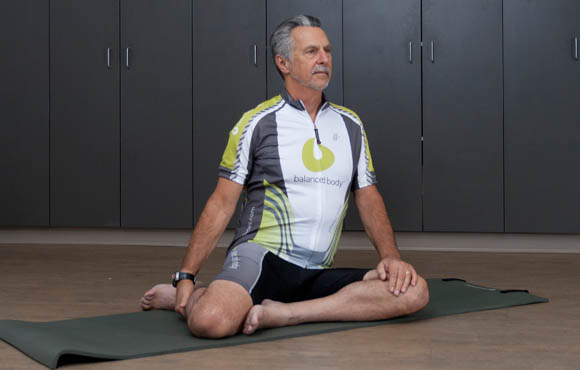
Sit on the floor with your legs in the shape of the letter Z, with your front leg in external rotation and back hip in internal rotation. The left leg will be in external rotation with the shin in front of you and the right back leg will be in internal rotation.
Find:
Your Next RideMermaid (2 of 3)
2 of 12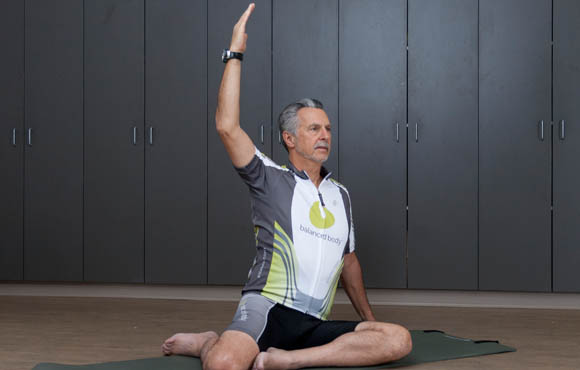
1. Begin by raising your arm overhead (on the same side as your front leg) and reaching over into a side bend. Raise the left arm up toward the ceiling and bend into a side bend to your right.
2. Reach towards the point where the wall and ceiling meet to help keep the spine long and avoid excessive disc compression.
3. Inhale at the top of the movement and exhale as you use your core to return to the starting position.
4. Repeat 3-5 times on one side, then switch leg positions and repeat.
Find:
Your Next RideMermaid (3 of 3)
3 of 12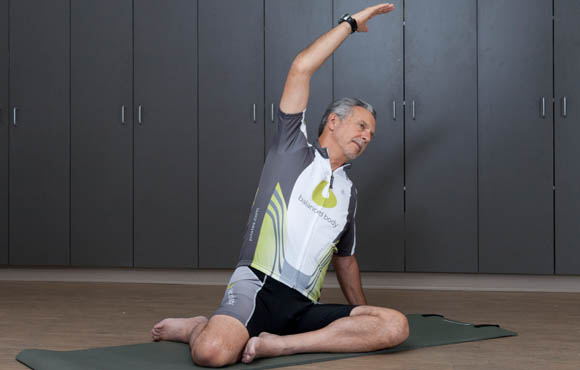
Dr. Toran's Take:
This exercise is one of a few that should be considered a staple in the cyclist's arsenal. Thoracic rib mobility and function is critical to breathe efficiently and "expansively."Comfort of the upper back, neck and shoulders hinges on a relaxed and supple ribcage. Performing the basic movement will help increase the available lung volume, helping cyclists to get enough air while pushing on the flats or up hills. The mermaid will improve the stability of the shoulder blade on the ribs as well as increase the available range of motion to the shoulder. A stable shoulder girdle will make those long stretches on the hoods or in the drops feel a little less long.
There are many ways to perform this exercise; leg position variations, arm position variations, trunk starting and ending position, as well as what Pilates apparatus is being used. All however have a lateral bending component. The lateral bending opens the ribs as it stretches the intercostal muscles and fascia. For the cyclist, deep, repetitive and deliberate breaths as the position is held, are vital to achieving the desired benefit.
Find:
Your Next RideOne-Legged Plank (1 of 2)
4 of 12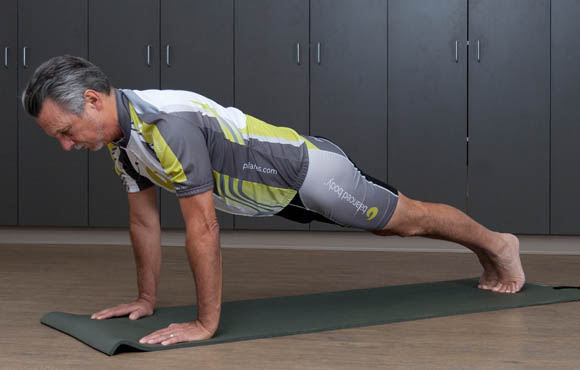
Position: Start in plank position with the wrists under the shoulders, the legs together and the body in one line from the head to the toes.
1. Keep your abs tight and engaged and make sure that your body is in a straight line.
2. Reach one leg off the floor while keeping the other foot on the mat.
3. Keep abs tight and hips level.
4. Hold for 30 seconds then switch legs, for a total of 3 sets with 30 seconds of rest in between each set.
Find:
Your Next RideOne-Legged Plank (2 of 2)
5 of 12
Dr. Toran's Take:
This is a very simple—if not easy—exercise. It also has many variations that will make it more challenging and effective. The most obvious benefit is shoulder alignment and stability. Plank work also promotes abdominal and lumbar strength and endurance. Both are sorely needed on long rides to reduce soreness. Variations such as raising one leg off the ground will challenge and develop rotational stability, which is very important for riding up hills.
One variation to consider is piking on the toes and pivoting through the shoulder. This is called the elephant exercise in Pilates. This movement further develops shoulder stability, abdominal strength and lower back flexibility, but also incorporates hamstring flexibility.
Find:
Your Next RideJack Rabbit (1 of 2)
6 of 12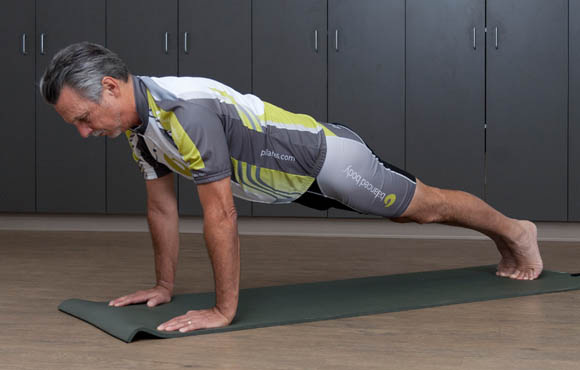
Position: Start in plank position with the wrists under the shoulders, the legs together and the body in one line from the head to the toes.
1. Lift one foot off the floor and bend the knee and hip to bring the leg under the torso. Alternate legs as if you are marching.
2. Tighten the abs to maintain the position of the torso as the legs move.
3. Continue for 5 to 10 sets, rest for 30 seconds and repeat three times.
Find:
Your Next RideJack Rabbit (2 of 2)
7 of 12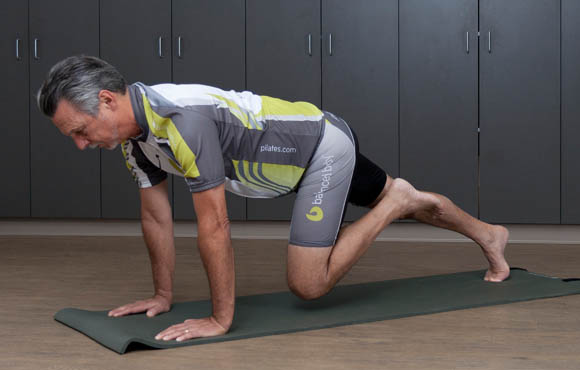
Dr. Toran's Take:
This is another exercise that will condition the shoulders, neck and upper back while promoting stability and alignment. This exercise also has the added benefit of increasing pedaling efficiency by improving foot-knee-hip-back alignment. As with most Pilates exercises, there are many variations to increase the challenge, including shifting your weight forward on the arms, isometric endurance on the standing leg and smooth articulation through the pedal stroke for the gesturing leg.
Find:
Your Next RideClimb a Tree (1 of 2)
8 of 12
Position: Lie down on your back.
1. Press the right leg into the mat and extend the left leg up toward the ceiling. Bend the left leg at the knee if your level of flexibility requires.
2. Use your hands to "climb" your leg towards your extended foot. Pull your forehead towards your knee for an extra stretch.
3. "Climb" back down, then repeat three times before switching legs.
4. Keep grounded leg pressed into the mat using your hamstrings and glutes.
Find:
Your Next RideClimb a Tree (2 of 2)
9 of 12
Dr. Toran's Take:
This is a very similar position to the elephant exercise, but rather than facing down, start supine (on the back). As one "climbs the tree," shoulder and neck alignment are reinforced. Lumbopelvic alignment under load is also challenged, while both the lumbar spine and hamstrings are stretched. Depending upon how the exercise is initiated, this can become a great abdominal workout as well.
Find:
Your Next RideStanding Shoulder Stretch (1 of 2)
10 of 12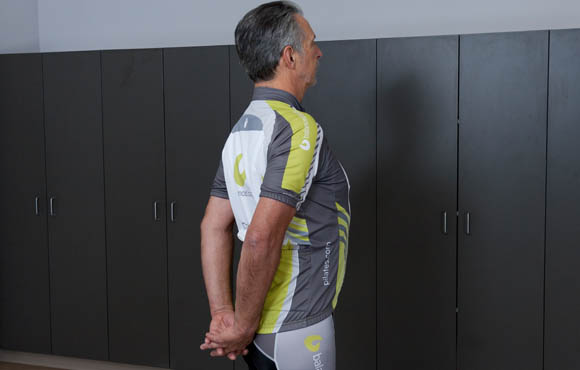
Position: Stand with your hands at your sides.
1. Reach your hands behind you and interlace your fingers. If the shoulders are too stiff, hold a towel between the hands.
2. Roll the shoulders back, open the chest and arch the upper back to feel a stretch across the front of the chest.
3. Hold for 30 seconds on each side and repeat three times.
Find:
Your Next RideStanding Shoulder Stretch (2 of 2)
11 of 12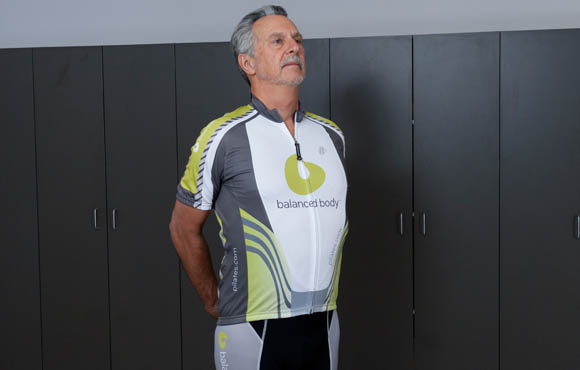
Dr. Toran's Take:
After long rides many cyclists suffer from shoulder and neck tightness. This simple stretch will help to alleviate that tension and will also open up the pectoral muscles after the previous shoulder and plank exercises. Finish with three or more of these stretches at the end of a workout and congratulate yourself on a job well done.







Discuss This Article